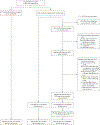Large-Scale Assessment of a Smartwatch to Identify Atrial Fibrillation
- PMID: 31722151
- PMCID: PMC8112605
- DOI: 10.1056/NEJMoa1901183
Large-Scale Assessment of a Smartwatch to Identify Atrial Fibrillation
Abstract
Background: Optical sensors on wearable devices can detect irregular pulses. The ability of a smartwatch application (app) to identify atrial fibrillation during typical use is unknown.
Methods: Participants without atrial fibrillation (as reported by the participants themselves) used a smartphone (Apple iPhone) app to consent to monitoring. If a smartwatch-based irregular pulse notification algorithm identified possible atrial fibrillation, a telemedicine visit was initiated and an electrocardiography (ECG) patch was mailed to the participant, to be worn for up to 7 days. Surveys were administered 90 days after notification of the irregular pulse and at the end of the study. The main objectives were to estimate the proportion of notified participants with atrial fibrillation shown on an ECG patch and the positive predictive value of irregular pulse intervals with a targeted confidence interval width of 0.10.
Results: We recruited 419,297 participants over 8 months. Over a median of 117 days of monitoring, 2161 participants (0.52%) received notifications of irregular pulse. Among the 450 participants who returned ECG patches containing data that could be analyzed - which had been applied, on average, 13 days after notification - atrial fibrillation was present in 34% (97.5% confidence interval [CI], 29 to 39) overall and in 35% (97.5% CI, 27 to 43) of participants 65 years of age or older. Among participants who were notified of an irregular pulse, the positive predictive value was 0.84 (95% CI, 0.76 to 0.92) for observing atrial fibrillation on the ECG simultaneously with a subsequent irregular pulse notification and 0.71 (97.5% CI, 0.69 to 0.74) for observing atrial fibrillation on the ECG simultaneously with a subsequent irregular tachogram. Of 1376 notified participants who returned a 90-day survey, 57% contacted health care providers outside the study. There were no reports of serious app-related adverse events.
Conclusions: The probability of receiving an irregular pulse notification was low. Among participants who received notification of an irregular pulse, 34% had atrial fibrillation on subsequent ECG patch readings and 84% of notifications were concordant with atrial fibrillation. This siteless (no on-site visits were required for the participants), pragmatic study design provides a foundation for large-scale pragmatic studies in which outcomes or adherence can be reliably assessed with user-owned devices. (Funded by Apple; Apple Heart Study ClinicalTrials.gov number, NCT03335800.).
Copyright © 2019 Massachusetts Medical Society.
Figures



Comment in
-
Watched by Apple.N Engl J Med. 2019 Nov 14;381(20):1964-1965. doi: 10.1056/NEJMe1913980. N Engl J Med. 2019. PMID: 31722159 No abstract available.
-
Bleibt bald kein VHF mehr unentdeckt?MMW Fortschr Med. 2019 Dec;161(21-22):30. doi: 10.1007/s15006-019-1224-y. MMW Fortschr Med. 2019. PMID: 31828643 German. No abstract available.
-
A Smartwatch to Identify Atrial Fibrillation.N Engl J Med. 2020 Mar 5;382(10):974. doi: 10.1056/NEJMc1916858. N Engl J Med. 2020. PMID: 32130824 No abstract available.
-
A Smartwatch to Identify Atrial Fibrillation.N Engl J Med. 2020 Mar 5;382(10):974. doi: 10.1056/NEJMc1916858. N Engl J Med. 2020. PMID: 32130825 No abstract available.
-
A Smartwatch to Identify Atrial Fibrillation.N Engl J Med. 2020 Mar 5;382(10):974-975. doi: 10.1056/NEJMc1916858. N Engl J Med. 2020. PMID: 32130826 No abstract available.
-
A Smartwatch to Identify Atrial Fibrillation.N Engl J Med. 2020 Mar 5;382(10):975. doi: 10.1056/NEJMc1916858. N Engl J Med. 2020. PMID: 32130827 No abstract available.
-
[Smartwatch: a tool for public health?].Geriatr Psychol Neuropsychiatr Vieil. 2020 Mar 1;18(1):5. doi: 10.1684/pnv.2020.0847. Geriatr Psychol Neuropsychiatr Vieil. 2020. PMID: 32160985 French. No abstract available.
-
Review article: Large-scale assessment of a smartwatch to identify atrial fibrillation. Perez, M, Mahaffey, K, Hedlin, H., et al.J Vasc Nurs. 2020 Jun;38(2):93-94. doi: 10.1016/j.jvn.2020.04.001. Epub 2020 May 4. J Vasc Nurs. 2020. PMID: 32534659 No abstract available.
References
-
- Apple. Using Apple Watch for arrhythmia detection. December 2018 (https://www.apple.com/healthcare/site/docs/Apple_Watch_Arrhythmia_Detect...).
-
- Colilla S, Crow A, Petkun W, Singer DE, Simon T, Liu X. Estimates of current and future incidence and prevalence of atrial fibrillation in the U.S. adult population. Am J Cardiol 2013; 112: 1142–7. - PubMed
Publication types
MeSH terms
Associated data
Grants and funding
LinkOut - more resources
Full Text Sources
Other Literature Sources
Medical
